ACTIA Group Bundle
Who Buys ACTIA Group's High-Tech Solutions?
Understanding the "who" behind a company's success is critical for investors and strategists alike. For ACTIA Group, a leader in electronic systems, knowing its customer demographics and target market is key to navigating a complex global landscape. From automotive to aerospace, ACTIA's reach is vast, making a deep dive into its customer base essential. This exploration will uncover the driving forces behind ACTIA's market position and future growth.
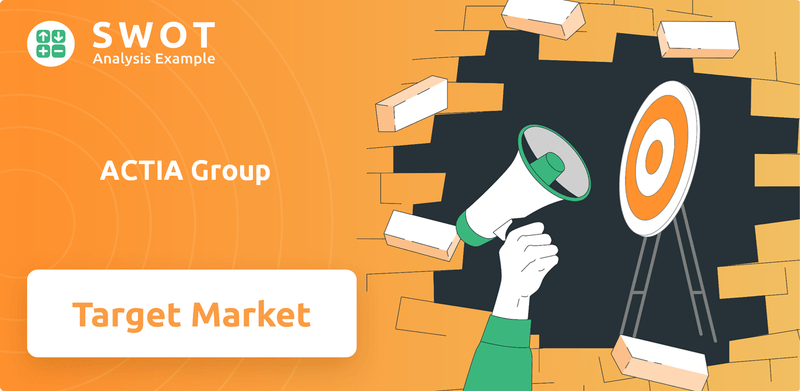
This analysis will delve into ACTIA Group SWOT Analysis, examining the company's strategic approach to market segmentation and customer profile development. We'll explore the specific needs and preferences of ACTIA's diverse clientele, including its customer demographics by industry and geographic region. By understanding ACTIA Group's target market analysis, we can gain valuable insights into its competitive advantages and potential for expansion, answering questions like "What are the customer demographics of ACTIA Group?" and "How does ACTIA Group define its target audience?"
Who Are ACTIA Group’s Main Customers?
Understanding the customer demographics and target market is crucial for assessing the strategic positioning of ACTIA Group. The company primarily operates in the business-to-business (B2B) sector, focusing on specific industries rather than directly serving consumers. This approach allows ACTIA to tailor its products and services to the specialized needs of its clients, enhancing its market competitiveness.
ACTIA's customer base is diverse, spanning several key sectors. These include manufacturers (OEMs), fleet operators, and after-sales networks. The company's organizational structure, effective January 1, 2024, is divided into four main divisions: Mobility, Aerospace, Energy, and Engineering Services. This segmentation helps to better align with and serve its target market.
A thorough Growth Strategy of ACTIA Group reveals the company's commitment to adapting to technological advancements and strategic partnerships, which further defines its customer demographics and target market.
The Mobility Division is the largest segment, accounting for 74.8% (€435.5 million) of total revenue in 2024. This division focuses on terrestrial mobility, including road and rail transport, goods and people transportation, and off-highway vehicles. The Bus & Coach business within Mobility showed growth in Q4 2024.
The Aerospace Division saw sales increase by 13.3% to €72.0 million in 2024, representing 12.4% of the Group's total sales. This segment primarily serves aeronautics customers, indicating a strong presence in the aerospace industry.
The Energy Division focuses on electricity management, transportation, and distribution. Sales reached €29.7 million in 2024, with a notable improvement of 36.9% in Q1 2025 to €8.2 million. This growth is supported by smart grid and infrastructure optimization contracts.
The Engineering Services Division, which designs embedded products and software services, experienced significant growth of 28.8% to €40.9 million in 2024. This growth is largely attributed to technological collaborations in Software Defined Vehicles.
The primary customer segments for ACTIA Group include OEMs, fleet operators, and after-sales networks. Market segmentation is crucial for understanding the diverse needs of these customers. The company's focus on B2B relationships allows for specialized product development and targeted marketing efforts.
- Manufacturers (OEMs): These customers integrate ACTIA's products into their own offerings.
- Fleet Operators: They utilize ACTIA's solutions for vehicle management and maintenance.
- After-Sales Networks: They rely on ACTIA for diagnostic equipment and support.
- Aerospace Customers: Specifically in the aeronautics sector, benefiting from specialized solutions.
ACTIA Group SWOT Analysis
- Complete SWOT Breakdown
- Fully Customizable
- Editable in Excel & Word
- Professional Formatting
- Investor-Ready Format
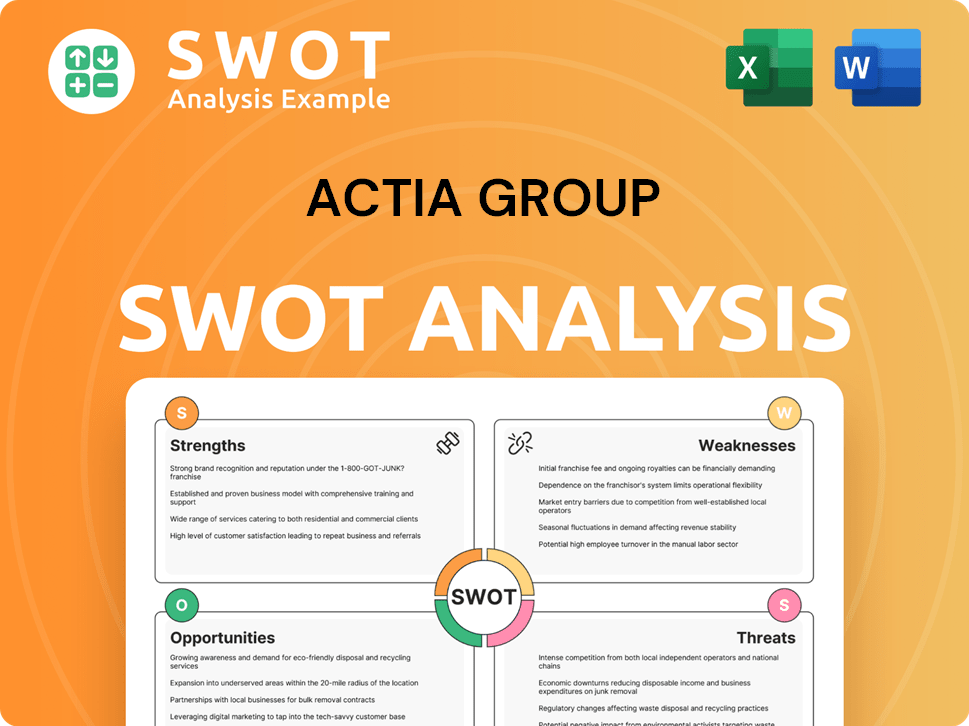
What Do ACTIA Group’s Customers Want?
Understanding the customer needs and preferences is crucial for businesses like the [Company Name]. This involves analyzing their customer demographics and conducting thorough target market analysis. The company's focus on innovation and quality directly addresses the needs of its B2B customers.
The company's customer base is primarily composed of B2B entities, emphasizing the importance of reliability, performance, and innovation in electronic systems and diagnostics. Their purchasing decisions are influenced by factors such as enhancing user experience, supporting energy transition, and promoting vehicle sustainability. Therefore, understanding their customer profile is essential.
Decision-making criteria often involve the integration of smart and upgradeable technologies, and solutions that support the evolution towards digitalized vehicles, including software-defined, electric, and autonomous vehicles. This customer-centric approach is vital for market segmentation and ensuring the company's offerings meet evolving industry demands. For more insights, you can refer to the Growth Strategy of ACTIA Group.
The company has been a pioneer in advanced diagnostics and telematics for over 30 years. More than 6 million units are in daily use across 130 countries, highlighting its significant market presence. This long-standing expertise addresses a critical customer need for reliable diagnostic solutions.
The company focuses on cybersecurity engineering, integrating standards like ISO/SAE 21434. This helps vehicle manufacturers meet regulatory requirements, which is a crucial aspect of customer needs in the automotive industry. This is a key factor in the customer demographics of [Company Name].
Customer feedback and market trends, particularly the shift towards Software Defined Vehicles (SDVs), have directly influenced product development. The collaboration with Ampere (Renault Group's EV entity) on embedded systems for SDVs demonstrates the company's adaptation to evolving industry demands. This shows how the company defines its target audience.
The company offers customized solutions to OEMs, fleet operators, and industrial partners. This emphasizes its ability to adapt product features and services to specific segment requirements. This approach addresses the diverse needs within its target market analysis.
The primary customer needs include reliability, quality, performance, and innovation in electronic systems and diagnostics. These factors are critical in the automotive, aerospace, and telecommunications sectors. These are the key demographics of the company's customers.
Market trends such as digitalization, electrification, and autonomous driving significantly influence customer preferences. These trends drive the demand for advanced diagnostics, telematics, and cybersecurity solutions. This highlights the company's target market segmentation strategies.
The company addresses several key customer needs through its products and services. The focus is on providing solutions that enhance vehicle performance, improve user experience, and support the transition to sustainable transportation. Understanding what are the customer needs the company addresses is important.
- Advanced diagnostics and telematics for vehicle maintenance and performance optimization.
- Cybersecurity solutions to protect vehicles from cyber threats.
- Customized solutions to meet specific OEM and fleet operator requirements.
- Support for the evolution towards digitalized, electric, and autonomous vehicles.
ACTIA Group PESTLE Analysis
- Covers All 6 PESTLE Categories
- No Research Needed – Save Hours of Work
- Built by Experts, Trusted by Consultants
- Instant Download, Ready to Use
- 100% Editable, Fully Customizable
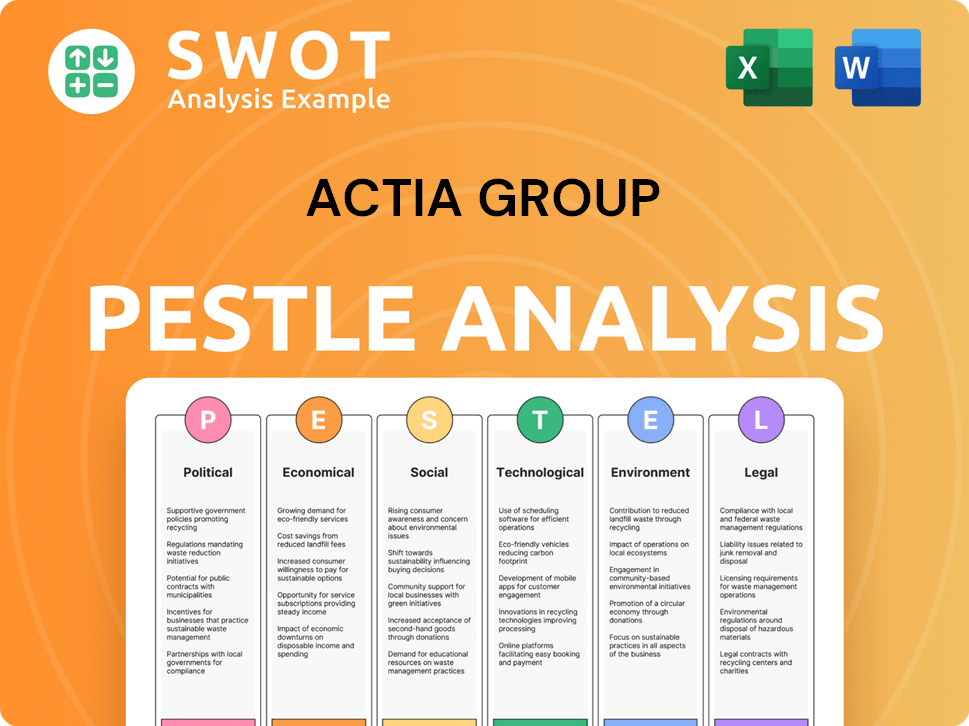
Where does ACTIA Group operate?
The geographical market presence of ACTIA Group is extensive, with operations spanning across 24 locations in 17 countries. This global reach is a critical component of its business strategy, enabling the company to serve a diverse customer base and capitalize on international market opportunities. International sales constitute a significant portion of its revenue, reflecting the company's commitment to global expansion and market penetration.
In 2024, international sales accounted for 58.5% of the consolidated turnover, demonstrating the importance of its global footprint. The distribution of net sales in 2024 shows a strong presence in France (41.5%), followed by Europe (excluding France) at 34.9%. The Americas contributed 12%, Asia 8.3%, and Africa and Oceania 3.1%, highlighting the company's diverse market reach. For a deeper understanding of the company's origins and evolution, you can refer to Brief History of ACTIA Group.
While some regions experienced fluctuations, the company's strategic focus on key markets like China and the United States remains strong. The company continues to adapt its offerings and partnerships to meet local market demands, ensuring sustained growth and competitiveness across its global operations. This approach is crucial for navigating the complexities of diverse markets and maintaining a strong position in the industry.
ACTIA Group's market segmentation strategy involves targeting various geographic regions and industry sectors. The company customizes its approach based on the specific needs and dynamics of each market. This includes tailoring its product offerings and marketing efforts to resonate with local customer preferences.
The company's primary geographic focus includes France, Europe (excluding France), the Americas, Asia, and Africa. In 2024, France saw sales growth of 5.6%, while China experienced strong performance with the Mobility division's sales up by 15.5% in Q4 2024. The United States also remains a strategic focus.
The customer demographics of ACTIA Group vary across its different divisions and geographic regions. The company serves a diverse range of customers, including those in the automotive, telecommunications, aerospace, and energy sectors. Understanding the customer profile is key to success.
A target market analysis helps ACTIA Group identify and focus on the most promising customer segments. This involves evaluating market size, growth potential, and competitive landscape. The company's strategic focus on China and the United States reflects its target market analysis.
For automotive solutions, ACTIA Group targets automotive manufacturers and suppliers. The customer profile includes companies seeking advanced diagnostic equipment and electronic systems. The Mobility division faced challenges in Europe (-21.5%) and the United States (-18.3%) in Q4 2024.
In the telecommunications sector, the company targets network operators and telecommunications equipment manufacturers. ACTIA Group provides solutions for network testing and maintenance. The company's customer base includes businesses that require reliable and efficient communication systems.
The aerospace industry is another key target market for ACTIA Group. The customer profile includes aerospace manufacturers and aviation service providers. The company's offerings include electronic systems and diagnostic equipment for aircraft.
For the energy sector, ACTIA Group targets utility companies and energy infrastructure providers. The Energy Division's growth in Q1 2025 was fueled by solutions for energy grids in France and contracts in Africa. This includes solutions for smart grids and electricity distribution optimization.
ACTIA Group's diagnostic equipment is targeted towards automotive repair shops and service centers. These customers require advanced tools for vehicle diagnostics and maintenance. Understanding the needs of these customers is essential for product development.
The company's customer base is spread across various geographic regions, including France, Europe (excluding France), the Americas, Asia, and Africa. The company adapts its offerings to meet the specific needs of each region. Strategic focus includes China and the United States.
ACTIA Group Business Model Canvas
- Complete 9-Block Business Model Canvas
- Effortlessly Communicate Your Business Strategy
- Investor-Ready BMC Format
- 100% Editable and Customizable
- Clear and Structured Layout
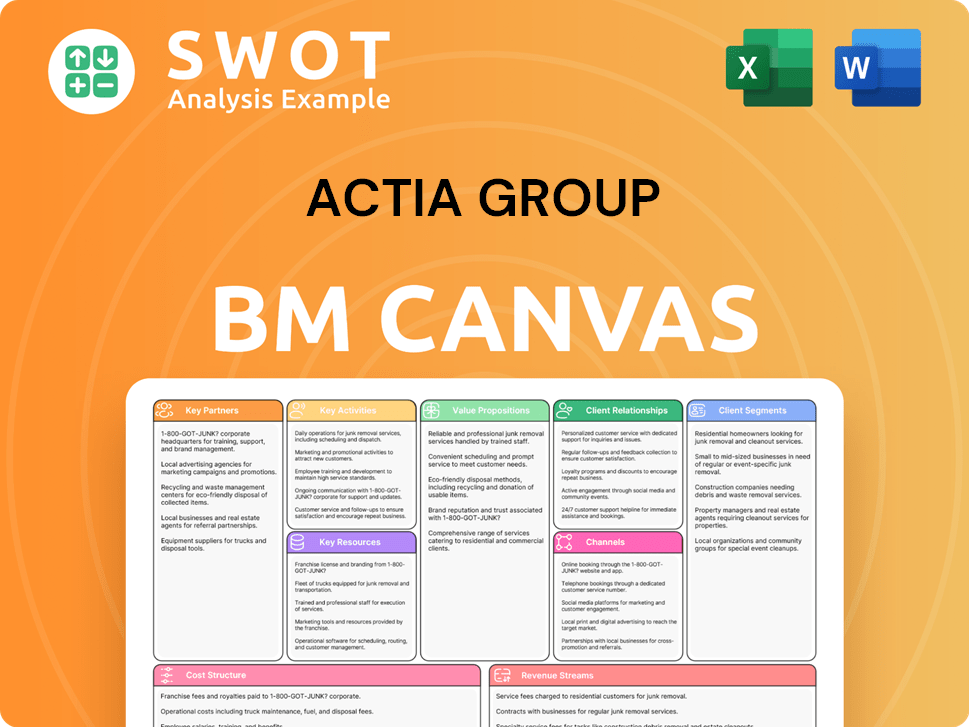
How Does ACTIA Group Win & Keep Customers?
The company's customer acquisition and retention strategies are centered on its B2B model, focusing on technological expertise and strategic partnerships. A key aspect of acquiring customers involves direct engagement with original equipment manufacturers (OEMs) and industrial partners. The company leverages its long-standing reputation and experience in vehicle diagnostics and embedded systems to attract new clients, which is a vital part of understanding the Owners & Shareholders of ACTIA Group.
Strategic collaborations are crucial for both acquiring and retaining customers. For instance, the technological partnership with Ampere (Renault Group) in Software Defined Vehicles (SDVs) strengthens the company's position in the automotive sector, which is estimated to generate approximately €40 million in 2024 from partnerships. This partnership includes the transfer of software solutions and the integration of a dedicated team, which shows a deep level of commitment designed for long-term relationships.
Retention efforts are supported by continuous investment in research and development (R&D), with approximately 14% to 18% of annual turnover reinvested in R&D. This ensures a continuous pipeline of innovative and sustainable solutions. The company's focus on quality, with all employees sharing a belief in quality, reinforces customer trust and loyalty. The diversification of the customer base across various sectors (automotive, rail, aerospace, energy) provides resilience against downturns in specific industries, which aids overall retention.
The company directly engages with OEMs and industrial partners to deliver customized electronic systems and solutions. This approach allows for tailored offerings that meet specific customer needs. The company's expertise in vehicle diagnostics and embedded systems, with over 30 years of experience, is a key selling point for attracting new clients, helping to understand the Customer demographics.
Strategic collaborations, such as the partnership with Ampere (Renault Group), are essential for both acquisition and retention. These partnerships enhance the company's market position and provide additional revenue streams, with about €40 million in estimated revenue from partnerships in 2024. These collaborations involve the transfer of software solutions and dedicated teams, fostering long-term relationships.
Continuous investment in research and development is a core strategy, with 14% to 18% of annual turnover allocated to R&D. This investment ensures a steady stream of innovative solutions. The focus on innovation helps the company maintain a competitive edge and meet evolving customer demands. This is a key element in Target market analysis.
The company emphasizes quality, with all employees sharing a commitment to quality within a fully certified environment. This focus builds customer trust and loyalty. The company's commitment to quality ensures that it consistently delivers reliable and high-performing products and services.
The company serves diverse sectors, including automotive, rail, aerospace, and energy. This diversification provides resilience against industry-specific downturns, which aids in customer retention. The ability to serve multiple industries helps to stabilize revenue streams and reduce risk.
- Automotive: Focus on vehicle diagnostics and embedded systems.
- Rail: Provides solutions for rail transportation.
- Aerospace: Offers products and services for the aerospace industry.
- Energy: Delivers solutions for the energy sector.
ACTIA Group Porter's Five Forces Analysis
- Covers All 5 Competitive Forces in Detail
- Structured for Consultants, Students, and Founders
- 100% Editable in Microsoft Word & Excel
- Instant Digital Download – Use Immediately
- Compatible with Mac & PC – Fully Unlocked
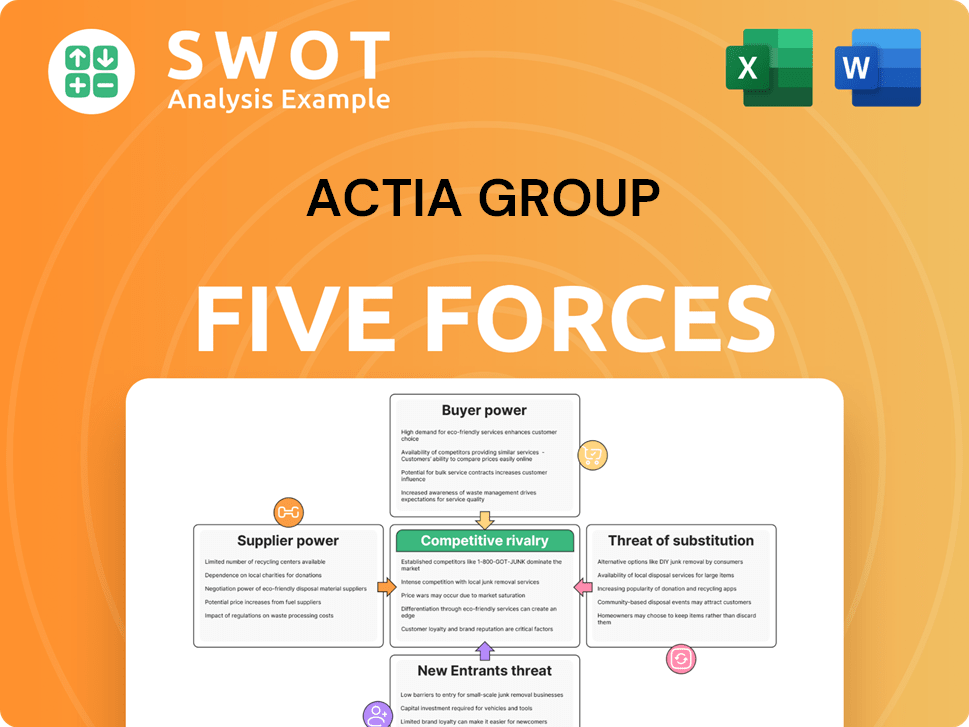
Related Blogs
- What are Mission Vision & Core Values of ACTIA Group Company?
- What is Competitive Landscape of ACTIA Group Company?
- What is Growth Strategy and Future Prospects of ACTIA Group Company?
- How Does ACTIA Group Company Work?
- What is Sales and Marketing Strategy of ACTIA Group Company?
- What is Brief History of ACTIA Group Company?
- Who Owns ACTIA Group Company?
Disclaimer
All information, articles, and product details provided on this website are for general informational and educational purposes only. We do not claim any ownership over, nor do we intend to infringe upon, any trademarks, copyrights, logos, brand names, or other intellectual property mentioned or depicted on this site. Such intellectual property remains the property of its respective owners, and any references here are made solely for identification or informational purposes, without implying any affiliation, endorsement, or partnership.
We make no representations or warranties, express or implied, regarding the accuracy, completeness, or suitability of any content or products presented. Nothing on this website should be construed as legal, tax, investment, financial, medical, or other professional advice. In addition, no part of this site—including articles or product references—constitutes a solicitation, recommendation, endorsement, advertisement, or offer to buy or sell any securities, franchises, or other financial instruments, particularly in jurisdictions where such activity would be unlawful.
All content is of a general nature and may not address the specific circumstances of any individual or entity. It is not a substitute for professional advice or services. Any actions you take based on the information provided here are strictly at your own risk. You accept full responsibility for any decisions or outcomes arising from your use of this website and agree to release us from any liability in connection with your use of, or reliance upon, the content or products found herein.